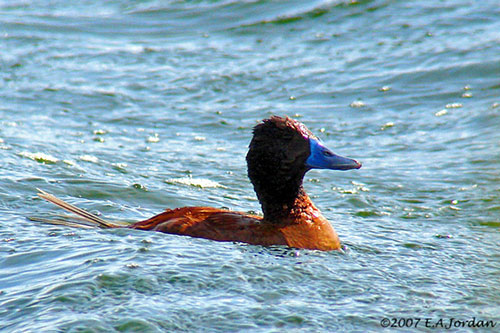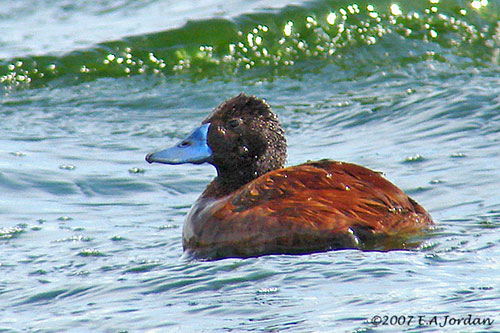
Fr: Érismature des Andes
Ang: Ruddy Duck
All: Andenruderente
Esp: Malvasía andina - Pato Andino - Pato rana de pico ancho
Ita: Gobbo delle Ande
Nd: Andesstekelstaart
Sd: andinsk kopparand
Photographers:
Roger Ahlman
Pbase Galleries Peru and Ecuador
Didier Buysse
Vision d’Oiseaux
Jean Michel Fenerole
Photos d’Oiseaux du monde
Eduardo Andrés Jordan
MIS AVES – AVES DE ARGENTINA
Text by Nicole Bouglouan
Sources:
HANDBOOK OF THE BIRDS OF THE WORLD vol 1 by Josep del Hoyo-Andrew Elliot-Jordi Sargatal - Lynx Edicions - ISBN: 8487334105
GUIDE DES CANARDS, DES OIES ET DES CYGNES – de Steve Madge - Delachaux et Niestlé - ISBN: 2603013769
Aves de los humedales chilenos: Guía de campo - De Pedro Pablo Rosso, Jaime Álvarez – Editeur: Ediciones UC, 2022 – ISBN: 9561430371, 9789561430372 – 240 pages
Birds of Northern South America: An Identification Guide: Species Accounts De Miguel Lentino, Robin Restall, Clemencia Rodner – Editor: Bloomsbury Publishing, 2020 – ISBN: 147298160X, 9781472981608 – 880 pages
A Wildlife Guide to Chile: Continental Chile, Chilean Antarctica, Easter Island, Juan Fernández Archipelago -
De Sharon Chester – Editor: Princeton University Press, 2010 – ISBN: 1400831504, 9781400831500 – 400 pages
Buscaves - Pato Rana de Pico Ancho
Arthur Grosset's Birds (Arthur Grosset)
Wikipedia, the free encyclopaedia
Andean Duck
Oxyura ferruginea
Anseriformes Order – Anatidae Family
INTRODUCTION:
The Andean Duck was formerly a subspecies of the Ruddy Duck, but it is now a full species with two subspecies. However, some taxonomic authorities still consider it conspecific.
It is native from the Andean Mountains of South America. It frequents ponds and lakes, up to 4,600 metres of elevation. In winter, it can be seen on freshwater lakes and streams at lower elevation.
It feeds mainly on seeds and roots of aquatic plants, also aquatic insects and crustaceans.
The species is monogamous for the season and nests in single pairs. The nest is a bowl usually built over water in dense emergent vegetation.
The Andean Duck is threatened by degradation and loss of its habitat caused by humans. Hunting and predation by invasive species may also have a negative impact. However, the species is not globally threatened at the moment.

DESCRIPTION OF THE BIRD:
Biometrics:
Length: 45-48 cm
Weight: 817-848 g
The Andean Duck male in breeding plumage has reddish chestnut body plumage.
On the underparts, central belly to inner flanks is mostly sooty, whereas lower belly to undertail-coverts is creamy white.
The tail is dark to blackish with stiff rectrices sometimes held at right angles to body.
The head and the rear neck are black, forming a hood. The chin is white.
The broad, concave-ridged bill is pale blue. The eyes are dark brown. Legs and webbed feet are grey.
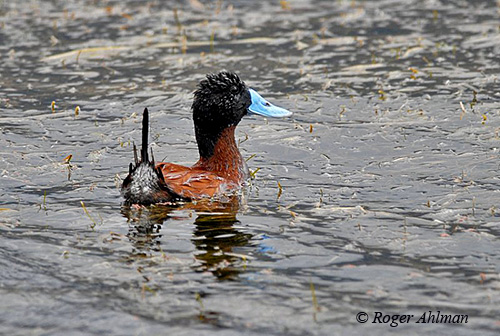
In non-breeding plumage, the male is dull grey-brown above and paler below. The head pattern resembles that of the Masked Duck, but with a single whitish line. The bill becomes dull grey.
The adult female in breeding plumage is almost entirely mid-brown to blackish, with narrow lateral barring on flanks. Central belly to undertail-coverts is creamy white.
In non-breeding plumage, the female resembles the female Masked Duck, but she has a single whitish line on the head.
The juvenile resembles female. It has pale facial patches and lead-coloured bill.
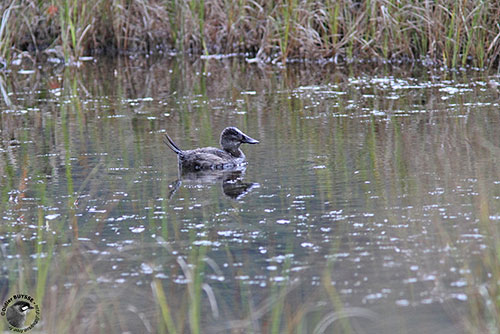
SUBSPECIES AND RANGE:
The Andean Duck has two subspecies.
O.f. ferruginea (described above) is found locally from Andes of S Colombia to S Argentina and S Chile.
O.f. andina occurs in Central and Eastern Andes of Colombia.
This race is intermediate between the Ruddy Duck and the nominate race, but there are marked individual variations. It has a variable white patch on the cheeks. Some extremes from entirely black to all white head are known (may be hybrid origin).
HABITAT:
The Andean Duck usually frequents freshwater swamps, lakes, pools, and marshes with emergent vegetation which are its favoured breeding habitats.
Outside breeding season, it also frequents larger lakes, brackish lagoons and estuaries.
The species is visible between 2,500 and 4,500 metres of elevation in the northern part of the range, but much lower in S Andes, and around 875 metres in E Bolivia.
The subspecies O.f. andina is recorded between 2,000 and 4,000 metres of elevation.
CALLS AND SONGS: SOUNDS BY XENO-CANTO
The Andean Duck is a silent species, especially the female. But during the courtship displays, the male produces mechanical drumming and bubbling noises. During this display, the male beats its breast with the bill. We can also hear a nasal “aarp”.
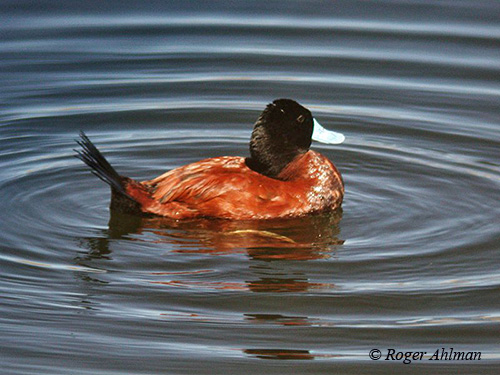
BEHAVIOUR IN THE WILD:
The Andean Duck feeds on aquatic invertebrates, aquatic insects and their larvae, crustaceans, molluscs, seeds and roots of aquatic plants.
This duck dives and swims underwater. They are usually found in scattered groups, rarely with other species of waterbirds. They spend most time floating low on the surface where they forage.
The Andean Duck feeds by diving. It often disappears for long periods beneath the water surface (like a grebe) before resurfacing a few minutes later.
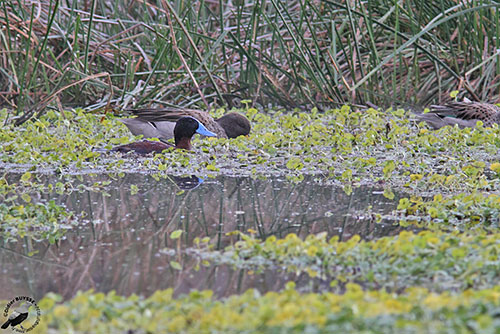
During the breeding season, the male performs some courtship displays, giving nasal sounds while beating its breast with the bill. The species is seasonally monogamous, with short-term pair-bonds.
The bulky nest is built by the female on floating vegetation in rushes and reedbeds. The female alone performs the nesting duties.
The Andean Duck is mainly sedentary, but it may perform only short movements.
The duck runs on the water, flapping its wings strongly before being able to take off and move away in a powerful flight.
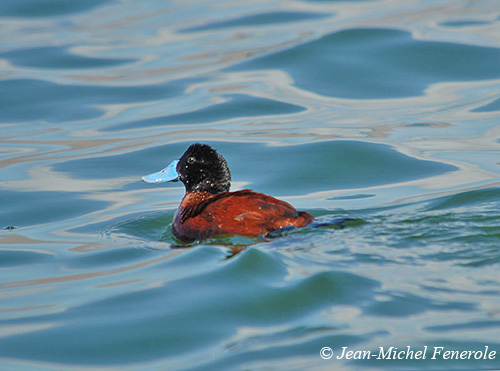
REPRODUCTION OF THIS SPECIES:
The breeding season varies, depending on the range. Eggs are found in April in Ecuador, in October-February in C Peru, in March in Bolivia, and November-December in Argentina. The species nests in single pairs.
Both adults select the nest-site, but the female alone builds the nest near water in marshy lakes and ponds with emergent vegetation.
She builds a bowl-shaped nest on the floating vegetation. It is made of dead (sometimes live) vegetation. It is occasionally lined with down. It is located in tall vegetation to protect it from predators.
The female lays 7-12 (usually 6-10) white eggs of fairly large size. She incubates alone during 24-26 days.
At hatching, the chicks have dark grey to olive-grey down above, whereas head-sides and underparts are paler and yellower. They probably fledge about 50-55 days after hatching.
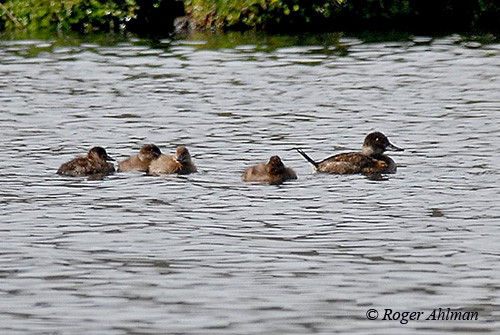
PROTECTION / THREATS / STATUS:
The Andean Duck is generally described as uncommon to fairly common.
It may be affected by degradation and loss of its habitat, especially wetlands in Peru.
The subspecies O.f. andina is scarce and local within a restricted range. The size of its population is roughly estimated at 10,000 individuals (2014).
The population of the nominate race is placed in the band 25,000/100,000 individuals (2014).
The overall trend is suspected to be declining.
But currently, the Andean Duck is evaluated as Least Concern.
